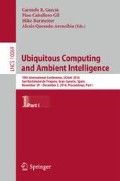Abstract
A methodology for mining data coming from mobile phone accelerometers is proposed in order to discover movement patterns in Alzheimer patients and to explore the relation of these patterns with the stage of the disease. This methodology processes the data provided by the accelerometer to extract features of the patient movement patterns. This information is used to train a neural network that relates the patient movement patterns with the stage of the disease (early, middle or late). This proposal based on neural network classifiers is compared with other machine learning classifiers. Moreover, this methodology is applied in a case study with 35 patients. Initial experiments are promising with a success rate up to 83 percent. The projection and exploitation of the results of our analysis are subject to ulterior extensive validation of the proposed technique.
Access this chapter
Tax calculation will be finalised at checkout
Purchases are for personal use only
References
Acampora, G., Cook, D.J., Rashidi, P., Vasilakos, A.V.: A survey on ambient intelligence in healthcare. Proc. IEEE 101(12), 2470–2494 (2013)
Anguita, D., Ghio, A., Oneto, L., Parra, X., Reyes-Ortiz, J.L.: Energy efficient smartphone-based activity recognition using fixed-point arithmetic 19(9), 1295–1314 (2013). http://www.jucs.org/jucs_19_9/energy_efficient_smartphone_based
Bravo, J., López-de-Ipiña, D., Fuentes, C., Hervás, R., Peña, R., Vergara, M., Casero, G.: Enabling NFC technology for supporting chronic diseases: a proposal for alzheimer caregivers. In: Aarts, E., Crowley, J.L., de Ruyter, B., Gerhäuser, H., Pflaum, A., Schmidt, J., Wichert, R. (eds.) AmI 2008. LNCS, vol. 5355, pp. 109–125. Springer, Heidelberg (2008)
Casale, P., Pujol, O., Radeva, P.: Personalization and user verification in wearable systems using biometric walking patterns. Pers. Ubiquit. Comput. 16(5), 563–580 (2011). http://dx.doi.org/10.1007/s00779-011-0415-z
Chung, P., Hsu, Y., Wang, C., Lin, C., Wang, J., Pai, M.: Gait analysis for patients with alzheimer’s disease using a triaxial accelerometer. In: ISCAS, pp. 1323–1326. IEEE (2012)
Corchado, J.M., Bajo, J., Abraham, A.: Gerami: Improving healthcare delivery in geriatric residences. IEEE Intell. Syst. 23(2), 19–25 (2008)
Dourish, P.: What we talk about when we talk about context. Pers. Ubiquit. Comput. 8(1), 19–30 (2004). http://dx.doi.org/10.1007/s00779-003-0253-8
Kasabov, N.K.: Foundations of Neural Networks, Fuzzy Systems, and Knowledge Engineering, 1st edn. MIT Press, Cambridge (1996)
Kirste, T., Koldrack, P., Schubert, S., Teipel, S.: Ambient Assisted Living: 7. AAL-Kongress 2014 Berlin, Germany, January 21–22, 2014. Detecting the Effect of Alzheimer’s Disease on Everyday Motion Behaviorpp. 149–156. Springer International Publishing, Cham (2015). http://dx.doi.org/10.1007/978-3-319-11866-6_12
McKhann, G., Drachman, D., Folstein, M., Katzman, R., Price, D., Stadlan, E.M.: Clinical diagnosis of alzheimer’s disease: Report of the nincdsadrda work group* under the auspices of department of health and human services task force on alzheimer’s disease. Neurology 34(7), 939 (1984). http://www.neurology.org/content/34/7/939.abstract
Reisberg, B., F.S.d.L.M.C.: The global deterioration scale for assessment of primary degenerative dementia. Am. J. Psychiatry 139(9), 1136–1139 (1982). pMID: 7114305
Villarreal, V., Hervas, R., Fontecha, J., Bravo, J.: Mobile monitoring framework to design parameterized and personalized m-health applications according to the patient’s diseases. J. Med. Syst. 39(10), 1–6 (2015). http://dx.doi.org/10.1007/s10916-015-0324-1
Weiser, M.: The computer for the 21st century. In: Human-Computer Interaction, pp. 933–940. Morgan Kaufmann Publishers Inc., San Francisco (1995). http://dl.acm.org/citation.cfm?id=212925.213017
Zheng, Y., Wong, W.K., Guan, X., Trost, S.: Physical activity recognition from accelerometer data using a multi-scale ensemble method (2013). http://aaai.org/ocs/index.php/IAAI/IAAI13/paper/view/6373
Acknowledgments
This work was partially supported by project PAC::LFO of the Spanish Programa Estatal de Fomento de la Investigación Científica y Técnica de Excelencia under grant MTM2014-55262-P, by project BASMATI of the Spanish Programa Nacional de Investigación, Ministerio de Ciencia e Innovación, under grant TIN2011-27479-C04-04 and by the Spanish Ministerio de Economía y Competitividad under grant MTM2014-56235-C2-2-P. We gratefully acknowledge the “Asociación de Familiares de Enfermos de Alzheimer en Cantabria” and Pablo Cobo García for their participation in the various studies.
Author information
Authors and Affiliations
Corresponding author
Editor information
Editors and Affiliations
Rights and permissions
Copyright information
© 2016 Springer International Publishing AG
About this paper
Cite this paper
Duque, R., Nieto-Reyes, A., Martínez, C., Montaña, J.L. (2016). Detecting Human Movement Patterns Through Data Provided by Accelerometers. A Case Study Regarding Alzheimer’s Disease. In: García, C., Caballero-Gil, P., Burmester, M., Quesada-Arencibia, A. (eds) Ubiquitous Computing and Ambient Intelligence. UCAmI 2016. Lecture Notes in Computer Science(), vol 10069. Springer, Cham. https://doi.org/10.1007/978-3-319-48746-5_6
Download citation
DOI: https://doi.org/10.1007/978-3-319-48746-5_6
Published:
Publisher Name: Springer, Cham
Print ISBN: 978-3-319-48745-8
Online ISBN: 978-3-319-48746-5
eBook Packages: Computer ScienceComputer Science (R0)

